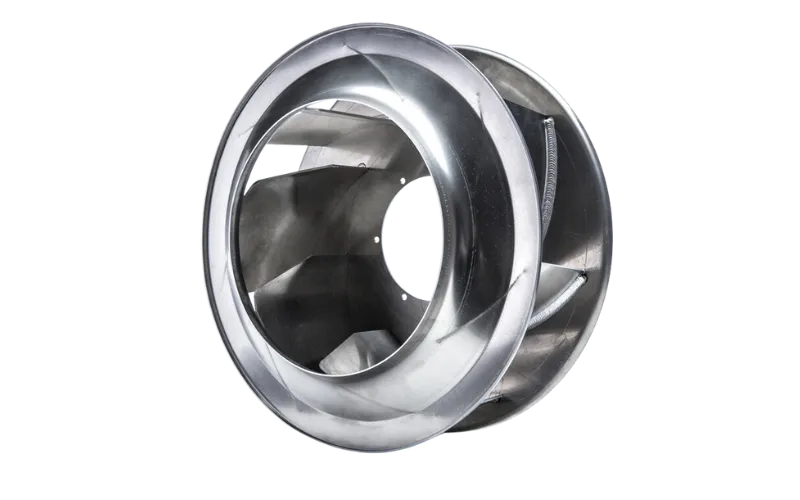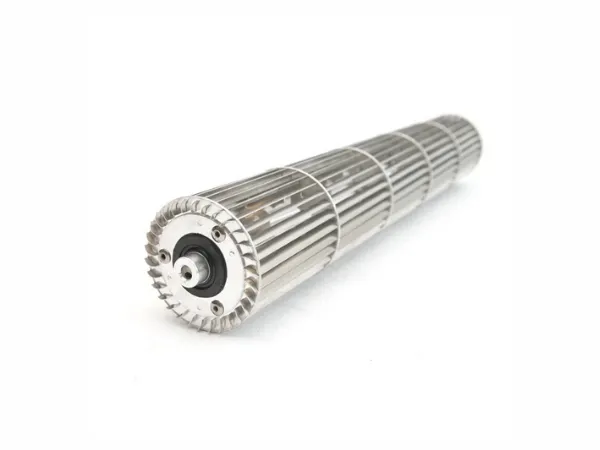Accurately measuring a blower wheel ensures your HVAC or ventilation system runs smoothly, efficiently, and safely. A blower wheel is a critical component that moves air through systems like heaters, air conditioners, or industrial machines. Incorrect measurements can lead to reduced airflow, increased noise, higher energy costs, or even equipment damage. This guide offers a clear, step-by-step approach to measuring a blower wheel, using simple tools anyone can handle. With over 20 years of experience, TSLBlower, a global leader in blower wheel manufacturing, shares expert insights to help you get it right.
Table of Contents
ToggleQuick Reference Table: Measuring a Blower Wheel
| Measurement | Tool Needed | Description |
|---|---|---|
| Diameter | Calipers or tape measure | Measure across the center from edge to edge |
| Width | Calipers or tape measure | Measure the air-moving section’s width |
| Hub Bore | Ruler or micrometer | Measure the central hole’s diameter |
| Rotation Direction | Visual inspection | Determine CW or CCW by blade tilt |
What Is a Blower Wheel and Why Does It Matter?
Understanding the Blower Wheel
A blower wheel is a fan-like blade that moves air or gas through systems such as heating, ventilation, and air conditioning (HVAC) units, or industrial setups for drying, cooling, or exhaust. It pulls air into its center and pushes it outward, creating essential airflow. These wheels are vital for maintaining comfort in homes or efficiency in factories.
Its Role in Systems
Blower wheels are found in axial, centrifugal, and exhaust fans, serving applications like chilling or suction. If the wheel is the wrong size or type, it can disrupt airflow, making the system work harder, use more energy, or even fail. For example, a mismatched wheel might overheat the motor, reducing its lifespan.
Materials and Benefits
Blower wheels are typically made from galvanized steel, aluminum, or plastic. Steel offers durability and corrosion resistance, ideal for tough environments. Aluminum is lightweight and rust-resistant, perfect for HVAC systems. Plastic wheels are cost-effective for less demanding uses. Choosing the right material ensures the wheel withstands operating conditions like temperature or humidity.
“Selecting the right blower wheel is critical for system performance,” says an expert from TSLBlower. “Even a small measurement error can lead to inefficiencies or damage.”
Why Accurate Blower Wheel Measurements Are Important
Ensuring Proper Fit
A blower wheel must fit perfectly within its housing and on the motor shaft. A wheel that’s too large won’t fit, while one that’s too small may wobble, causing vibrations that damage the system. Precise measurements ensure a secure, stable fit.
Maximizing Performance
The wheel’s size and type directly affect airflow. A mismatched wheel can reduce heating or cooling efficiency, impacting comfort or productivity. Accurate measurements ensure the wheel delivers the designed airflow for Ascential fan performance.
Saving Energy and Costs
An incorrectly sized wheel forces the motor to work harder, increasing energy use and utility bills. Proper sizing, as noted by Electric Trading Company, optimizes airflow and reduces energy consumption.
Enhancing Safety and Longevity
Mismatched wheels can cause overheating or mechanical failure, posing safety risks like fire hazards. They also wear out motors and components faster, leading to costly repairs. Accurate measurements extend equipment life and maintain safety.
Tools You’ll Need to Measure a Blower Wheel
Essential Measuring Tools
To measure a blower wheel accurately, gather these tools:
- Calipers or Tape Measure: For measuring diameter and width. Calipers offer higher precision.
- Ruler or Micrometer: For the hub bore diameter, where accuracy is critical.
- Protractor (Optional): For blade angles in specialized cases.
- Visual Inspection: To check rotation direction by observing blade tilt.
Tool Tips
Ensure tools are in good condition and calibrated. If you’re new to using them, practice on a spare object first. For complex measurements, consult TSLBlower’s team for guidance.
Step-by-Step Guide to Measuring a Blower Wheel

Step 1: Measure the Diameter (Outside Diameter)
The diameter defines the wheel’s size. Place the wheel on a flat surface. Use calipers or a tape measure to measure across the center, from one outer edge to the opposite edge. Take the widest point if the wheel isn’t perfectly round. Record in inches or millimeters.
Step 2: Measure the Overall Width
Width impacts airflow volume. Position the wheel to access both faces. Measure the air-moving section’s thickness, excluding the hub, using calipers or a tape measure. If width varies, measure multiple points and average them.
Step 3: Measure the Hub Bore (Mounting Shaft Diameter)
The hubbore must match the motor shaft. Locate the central hole. Use a ruler or micrometer to measure its inside diameter. Precision is key to avoid misalignment.
Step 4: Check the Rotation Direction
Rotation direction affects airflow. View the wheel from the hub side. If blades tilt right, it’s clockwise (CW); if left, counterclockwise (CCW). Check for markings indicating direction.
Optional: Measure Blade Dimensions (If Needed)
For custom wheels, measure blade height, angle, or count. Use a protractor for angles and a ruler for height. This is rare for standard replacements but useful for specialized applications.
Types of Blower Wheels and How Measurements Vary
Forward Curved Blower Wheels
Blades curve with rotation, ideal for HVAC systems moving large air volumes at low pressure. Focus on diameter and width measurements. See TSLBlower’s forward curved wheels.

Backward Curved Blower Wheels
Blades curve against rotation, offering high efficiency for higher pressures. Measure diameter, width, and blade angle. Explore TSLBlower’s backward curved wheels.

Cross Flow Blower Wheels
Long, cylindrical wheels for uniform airflow, used in electronics cooling. Width is critical. Check TSLBlower’s cross flow wheels.

| Type | Blade Curvature | Typical Use | Key Measurements |
|---|---|---|---|
| Forward Curved | With rotation | HVAC, low pressure | Diameter, width |
| Backward Curved | Against rotation | High efficiency | Diameter, width, blade angle |
| Cross Flow | Straight or curved | Uniform airflow | Length, diameter |
Tips for Ordering Custom Blower Wheels
Provide Precise Measurements
Submit exact diameter, width, hub bore, and rotation direction. Accuracy prevents delays or errors in production.
Choose the Right Material
Select materials like steel or aluminum based on temperature and environment. Specify ratings for heat or corrosion resistance.
Consult Experts
TSLBlower’s team offers design support to match your system’s needs. Their 20 years of experience ensure quality.
Plan for Lead Times
Custom wheels take 3-7 days for samples, 20-25 days for bulk. Order early to avoid downtime.
Common Mistakes to Avoid When Measuring
Not Removing the Wheel
Measuring in place is less accurate. Remove the wheel for clear access to all dimensions.
Ignoring Rotation Direction
Wrong rotation reduces airflow and strains the system. Always verify CW or CCW.
Using Imprecise Tools
Rough estimates lead to errors. Use calibrated calipers or micrometers for precision.
Single Measurements
Measure twice to confirm accuracy. Small errors can cause big problems.
How TSLBlower Ensures Quality Blower Wheels
Rigorous Quality Control
Every wheel undergoes 100% inspection before shipping, ensuring top standards. This minimizes defects and ensures reliability.
Customization Expertise
With 20 years in plastic injection molding, TSLBlower tailors wheels to exact specifications, meeting unique needs.
Comprehensive Support
From design to delivery, TSLBlower manages projects efficiently, ensuring timely, high-quality results.
Customer Commitment
TSLBlower builds lasting partnerships, offering unmatched service. Contact them at TSLBlower’s support page.
Frequently Asked Questions (FAQs)
How do I know the size of my blower wheel?
Measure the outside diameter, overall width, and hub bore diameter using calipers or a micrometer. These dimensions define the wheel’s size for replacements or custom orders.
What tools do I need to measure a blower wheel?
Use calipers or a tape measure for diameter and width, a ruler or micrometer for hub bore, and visual inspection for rotation direction. A protractor may help for blade angles.
Why is the rotation direction important?
Rotation direction ensures proper airflow. Incorrect direction reduces efficiency, increases noise, and risks damage. Check blade tilt to confirm CW or CCW.
Can I measure the blower wheel without removing it?
Yes, but it’s less accurate. Removing the wheel allows precise measurements, especially for width and hub bore, ensuring better fit and performance.
What materials are blower wheels made from?
Common materials include galvanized steel, aluminum, and plastic. Steel is durable, aluminum is lightweight, and plastic is cost-effective, each suited to specific conditions.
Conclusion
Key Takeaways
Measuring a blower wheel accurately is simple with the right tools and steps. Precise measurements ensure proper fit, optimal performance, energy efficiency, and equipment safety. By following this guide, you can avoid common mistakes and select the right wheel for your system.
Partner with TSLBlower
For high-quality blower wheels or custom solutions, trust TSLBlower. With over 20 years of expertise, they offer reliable products and expert support. Visit their website or contact their team to explore their range and get personalized assistance.
Act Now
Don’t let incorrect measurements disrupt your system. Start measuring today and ensure your equipment runs smoothly for years. Reach out to TSLBlower for top-tier blower wheels and unmatched service.
